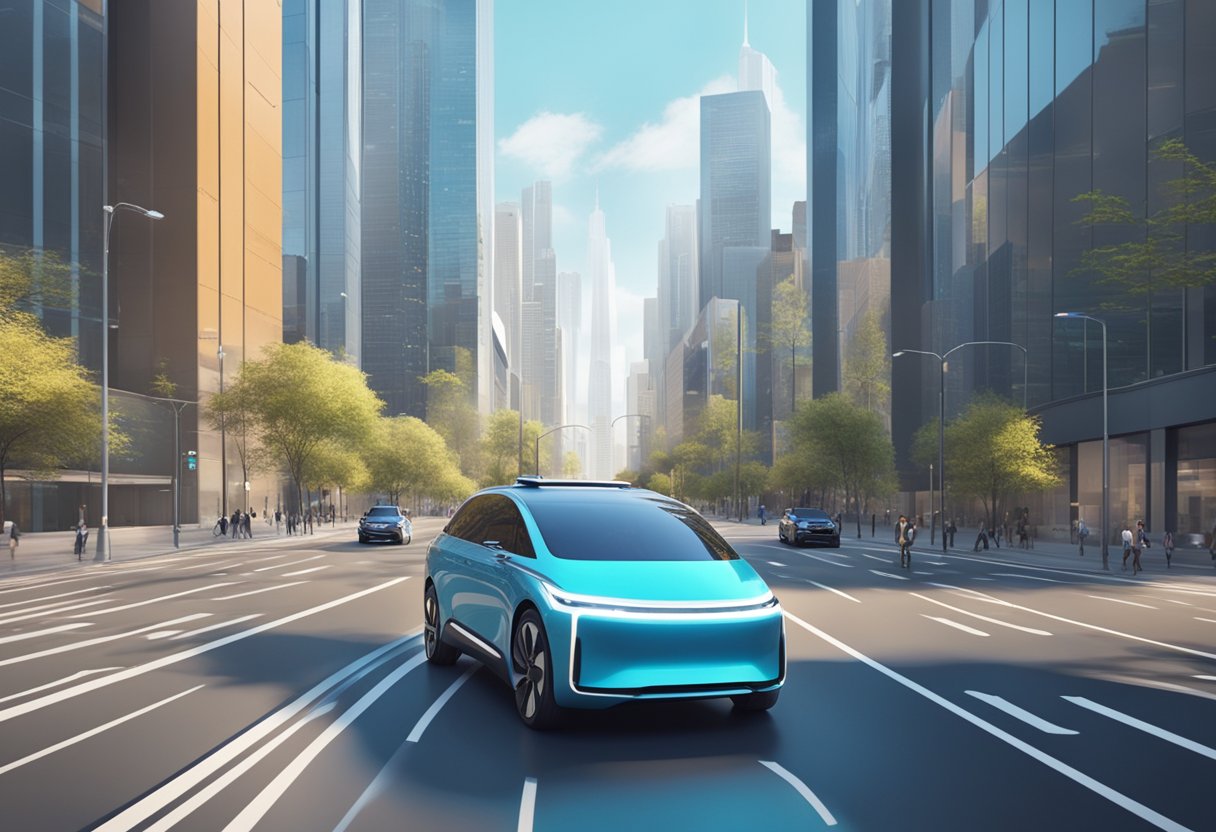Autonomous driving cars are no longer a futuristic concept, but a rapidly advancing reality. As technology continues to evolve, the integration of artificial intelligence (AI) in autonomous driving cars is becoming increasingly prevalent.
AI is the driving force behind the development of autonomous driving cars, and it is expected to play a significant role in shaping the future of the automotive industry.
AI technology has the potential to revolutionize the way we drive by improving safety, reducing traffic congestion, and enhancing the overall driving experience.
Autonomous driving cars rely on AI to process vast amounts of data collected from sensors, cameras, and other sources to make decisions in real-time. This technology enables cars to navigate complex traffic situations, detect obstacles, and respond to changing road conditions, all without human intervention.
As the technology continues to advance, the future of AI in autonomous driving cars looks promising. However, there are still challenges that need to be addressed, such as ethical considerations, cybersecurity, and legal issues.
Despite these challenges, the integration of AI in autonomous driving cars is expected to continue to grow, and it will be interesting to see how this technology shapes the future of transportation.
Evolution of Autonomous Driving Technology

Autonomous driving technology has come a long way since its inception. From the early days of Advanced Driver Assistance Systems (ADAS) to the current state of full self-driving, the technology has made significant strides.
In this section, we will explore the evolution of autonomous driving technology and the milestones achieved along the way.
From ADAS to Full Self-Driving
ADAS was the first step towards autonomous driving technology. It provided features such as lane departure warning, automatic emergency braking, and adaptive cruise control. These features helped drivers avoid accidents and made driving safer.
However, ADAS was not fully autonomous and required human intervention.
The next step was automation, which aimed to reduce human intervention further. The Society of Automotive Engineers (SAE) developed a classification system for autonomous driving, which ranges from level 0 to level 5.
Level 3 automation was the first step towards fully autonomous driving, where the vehicle could take control in certain situations. Level 4 automation is where the vehicle can operate without human intervention in most situations, and level 5 automation is fully autonomous driving.
Full self-driving is the ultimate goal of autonomous driving technology. It aims to provide a completely autonomous driving experience without any human intervention. Companies such as Tesla, Waymo, and Cruise are working towards achieving this goal.
Milestones in Autonomous Vehicle Development
The development of autonomous vehicles has achieved several milestones over the years.
In 2015, Tesla introduced its Autopilot system, which was the first mass-market ADAS system. In 2017, Waymo introduced its fully autonomous ride-hailing service in Arizona.
In 2018, General Motors announced that it would launch a commercial self-driving taxi service in 2019. However, the launch was delayed due to technical issues.
In 2020, Waymo launched its fully autonomous ride-hailing service in Phoenix. The service is available to the general public and does not require a safety driver. Tesla also announced that it had achieved level 5 autonomy, although it is yet to be fully implemented.
AI’s Role in Autonomous Vehicles

Artificial Intelligence (AI) plays a crucial role in the development of autonomous vehicles. It enables the vehicles to perceive their surroundings, make decisions, and take actions without human intervention. Here are some of the ways AI is utilized in autonomous vehicles:
Machine Learning and Decision-Making
Machine learning is a subset of AI that enables vehicles to learn from data and make decisions based on that data.
It allows the vehicle to adapt to different driving scenarios and make decisions based on the situation at hand. For example, if the vehicle encounters a construction zone, it can use machine learning to adjust its driving behavior and navigate through the zone safely.
Perception and Sensor Technologies
Perception and sensor technologies are critical components in autonomous vehicles. They enable the vehicle to perceive its surroundings and collect data about its environment.
Cameras, lidar, and radar are some of the sensors used in autonomous vehicles. AI is used to process the data collected by these sensors and make decisions based on that data.
Neural Networks and Processing
Neural networks are a type of AI that enables the vehicle to process data quickly and efficiently. They are modeled after the human brain and can learn from data and make decisions based on that data.
Processing power is also critical to the performance of autonomous vehicles. AI is used to optimize the processing power of the vehicle and ensure that it can make decisions in real-time.
Safety and Reliability in Autonomous Cars

As autonomous driving technology continues to evolve, safety and reliability remain the top concerns for both manufacturers and consumers. AI is expected to play a crucial role in ensuring the safety and reliability of autonomous cars.
Cybersecurity Measures
One of the biggest concerns with autonomous cars is the potential for cyber attacks. Hackers could potentially take control of the car’s systems, putting the passengers and other drivers on the road in danger.
To prevent this, manufacturers are implementing various cybersecurity measures, such as encryption, firewalls, and intrusion detection systems.
Predicting and Handling Unpredictable Human Behavior
Another challenge for autonomous cars is predicting and handling unpredictable human behavior. Pedestrians, cyclists, and other drivers on the road can behave erratically, making it difficult for autonomous cars to make split-second decisions.
To address this, AI algorithms are being developed to analyze and predict human behavior, allowing the car to make more informed decisions in real-time.
Weather and Environmental Challenges
Autonomous cars also face challenges when it comes to weather and environmental conditions. Heavy rain, snow, and fog can obstruct sensors and cameras, making it difficult for the car to navigate the road.
To address this, manufacturers are developing advanced sensors and cameras that can still function in adverse weather conditions. Additionally, AI algorithms are being developed to help the car adjust its driving behavior based on environmental conditions.
Regulatory and Ethical Considerations

Government Regulation and Standards
The development of autonomous driving cars has prompted governments to establish regulations and standards to ensure the safety of road users.
In the United States, the National Highway Traffic Safety Administration (NHTSA) has issued guidelines for the testing and deployment of autonomous vehicles. The guidelines cover areas such as data recording and sharing, cybersecurity, and crashworthiness.
The Society of Automotive Engineers (SAE) has also developed a framework for the classification of autonomous vehicles, ranging from Level 0 (no automation) to Level 5 (full automation).
Other countries have also established regulations for autonomous vehicles. In Europe, the European Union has issued guidelines for the testing and deployment of autonomous vehicles.
These guidelines cover areas such as data protection, cybersecurity, and ethical considerations. In China, the government has issued guidelines for the testing and deployment of autonomous vehicles. These guidelines cover areas such as safety, data security, and environmental protection.
Ethical Implications of AI in Driving
The use of AI in autonomous driving cars raises ethical considerations.
One of the main concerns is the decision-making process of the AI system in the event of an accident. For example, if a car is faced with the choice of hitting a pedestrian or crashing into a wall, what decision will the AI system make? This raises questions about the responsibility of the car manufacturer and the ethical implications of the decision-making process.
Another ethical consideration is the potential impact of autonomous driving cars on employment. As more jobs become automated, there is a risk that many people may lose their jobs.
This could have a significant impact on society, and it is important to consider the ethical implications of these changes.
The Impact of Autonomous Driving on Society

As autonomous driving technology continues to advance, it is expected to have a significant impact on society. This section will explore some of the ways in which autonomous driving is likely to shape the future of transportation.
Reducing Traffic Congestion and Emissions
One of the most significant benefits of autonomous driving is the potential to reduce traffic congestion and emissions.
With self-driving cars, traffic patterns can be optimized to reduce congestion and minimize the time spent idling in traffic. This could lead to significant reductions in emissions, as well as a more efficient use of road infrastructure.
In addition, self-driving cars have the potential to reduce the number of accidents on the road. This could lead to fewer traffic jams caused by accidents and less time spent waiting for emergency services to clear the scene.
Shaping Urban Mobility and Infrastructure
Autonomous driving technology is also likely to have a significant impact on urban mobility and infrastructure.
For example, self-driving cars could reduce the need for parking spaces, as they could drop off passengers and then park themselves in more remote locations. This could free up space in urban areas for other uses, such as parks or bike lanes.
In addition, autonomous driving technology could lead to more sustainable and eco-friendly transportation options.
For example, self-driving electric cars could be used for ride-sharing services, reducing the number of cars on the road and lowering emissions.
While there are still many challenges to overcome, such as regulatory frameworks and public acceptance, the potential benefits of this technology are clear.
As autonomous driving technology continues to advance, it will be interesting to see how it shapes the future of transportation and urban infrastructure.



